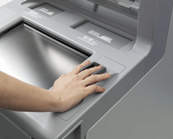 February 13, 2012 – Turkey’s İşbank has completed implementation of around 3,400 Finger Vein scanners including 2,400 units in ATMs and 1,000 units in branches in all cities across the Turkish territory, enabling customers to withdraw cash without a card. Hitachi’s finger vein authentication technology uses light to read the unique pattern of veins inside the finger. The system is widespread in Japan, where more than 75,000 finger vein-based ATMs have been installed since 2006 but the Isbank deployment is the largest in EMEA (Europe, Middle East and Africa).
February 13, 2012 – Turkey’s İşbank has completed implementation of around 3,400 Finger Vein scanners including 2,400 units in ATMs and 1,000 units in branches in all cities across the Turkish territory, enabling customers to withdraw cash without a card. Hitachi’s finger vein authentication technology uses light to read the unique pattern of veins inside the finger. The system is widespread in Japan, where more than 75,000 finger vein-based ATMs have been installed since 2006 but the Isbank deployment is the largest in EMEA (Europe, Middle East and Africa).
The bank has worked with technology vendor MIG International to install the authentication scanners in 2.400 NCR and Wincor Nixdorf ATMs. Michael Gorgi, CEO of MIG explained: “Finger vein modules are very compact in size and we were able to integrate with all of the different types of ATMs in use by the bank”.
 The new authentication service called ‘Biyokimlik’ (Bio-identity) is available for card and non-card transactions for İşbank customers. İşbank is planning to expand this service to create the largest biometric POS (Point-of-sale) network in the world. Currently biometric POS devices using Finger Vein technology are being tested in the field with several merchants. İşbank presented this innovation to the world during the last CeBIT Turkey event in 2011.
The new authentication service called ‘Biyokimlik’ (Bio-identity) is available for card and non-card transactions for İşbank customers. İşbank is planning to expand this service to create the largest biometric POS (Point-of-sale) network in the world. Currently biometric POS devices using Finger Vein technology are being tested in the field with several merchants. İşbank presented this innovation to the world during the last CeBIT Turkey event in 2011.
Hakan Aran, CIO, Isbank, says: „Our customers seem to be genuinely interested in the idea of using biometrics in banking and payments transactions and Isbank will continue to innovate with new services based on biometrics.”
İşbank followed the lead of the Polish banking sector. Poland was the first market in Europe to adopt Finger Vein technology in banking and Tadeusz Woszczynski, Head of the Security Solutions Group for Hitachi Europe in Poland said: “The large implementation of finger vein scanners on ATMs in Turkey followed on soon after the implementations by a number of Agricultural Banks in Poland. We were able to apply the lessons learned in the Polish market to the case of İşbank in Turkey. Since we had already resolved most of the technical challenges for deploying biometrics on a variety of different ATMs both indoors and outside, the timelines for the implementation were shortened and İşbank was able to offer biometric services within a few months of their decision to proceed.”
About Finger Vein Authentication Technology
Feature and mechanism of finger vein authentication system: The finger vein pattern recognition technology uses the vein pattern of the finger as the key biometric feature. The finger vein pattern is impossible to counterfeit because the vein is inside the body. With some of the existing biometric systems, it is possible to acquire data without the knowledge of the individual [e.g. finger-print, facial recognition, iris-scan etc.] It is not possible to acquire the finger vein biometric feature without knowing consent of the individual, which means that from a societal aspect, finger vein pattern recognition is safe and secure for the individual.
In operation, the process of data collection is based on a contact-less principle. Light penetrates through the finger using a light-transmission technique to allow the detection of the vein pattern. The vein pattern is image-processed using a special algorithm resulting in digital data that can be stored in a relevant data repository. The reading device is compact and can be applied in a variety of ways including for car entry, personal authentication, PC login, door access systems and validation for ATM machines.
Banking 4.0 – „how was the experience for you”
„To be honest I think that Sinaia, your conference, is much better then Davos.”
Many more interesting quotes in the video below: